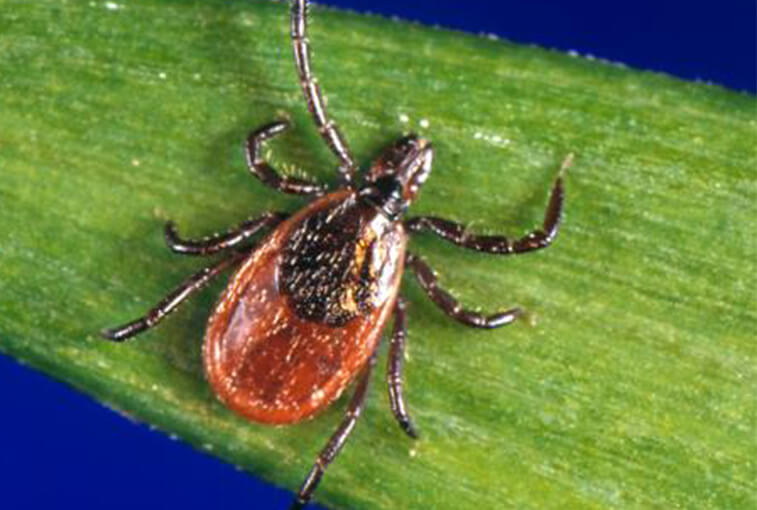Ticks are what nightmares are made of.
With eight legs, a mouthful of hooks, a creepy-crawly appearance that comes in a hard-to-detect package and bodies that swell as they gorge themselves on the blood of their hosts, ticks are unpleasant just to think about — never mind actually encountering one.
But, if you do, Kayla Norenberg, M.D., a Sanford Health family physician, suggests removing it as soon as possible.
Enlarge

“You will want to remove it ASAP. Tweezers are your best bet for that process,” she said.
“Grab the tick’s body as close to your skin as possible and be careful not to crush it. This is important as Borrelia burgdorferi, the tick-borne bacteria that causes Lyme disease, resides inside the tick, and squeezing could result in it leaking out, which is not something you want.”
And contrary to widely held belief, twisting is not the right approach.
“If you twist the tick, barbs on its legs could get stuck in your skin or hair and complicate removal. It’s best to pull straight up and avoid twisting altogether,” Dr. Norenberg said.
Once removed, the area should be rinsed with soapy water and monitored closely. As for disposing of the tick, Dr. Norenberg recommends flushing it down the toilet.
“That’s the simplest way. You can also place the tick in a small amount of rubbing alcohol or put it in a sealed bag or plastic container for a while. That’ll do the trick too.”
Lyme disease symptoms
Some of the earliest Lyme disease symptoms a person might notice include:
- A bull’s-eye rash in the location of the bite
- Flu-like symptoms such as headaches, fatigue, muscle and joint pain
- Loss of appetite
And, in this case, early doesn’t really mean what you’d think.
“It usually takes two to three weeks for those symptoms to be noticed after a person receives a tick bite. If symptoms are not recognized and treated in these early stages, early disseminated disease results. At that point, symptoms gradually become more severe,” Dr. Norenberg said.
Neurological and cardiological symptoms are tougher to detect but become more common at this stage of Lyme disease. Intermittent arthritis, often affecting the knee joints, also becomes persistent, along with cognitive disturbances and numbness in the arms and legs. In worst-case — and extremely rare — scenarios, cardiac complications resulting from Lyme disease can even lead to death.
So yeah, staying tick-free is a pretty big deal.
Upper Midwest a Lyme disease hot spot
The Centers for Disease Control and Prevention estimates about 300,000 people in the United States get Lyme disease each year. Nationally, most infections occur in the following areas where Lyme disease is endemic:
- Northeast and mid-Atlantic, from northeastern Virginia to Maine
- North central states, mostly in Wisconsin and Minnesota
- West Coast, particularly northern California
Within the region Sanford Health serves, the CDC reported 359 people were diagnosed in Iowa in 2021 — the most recent data available — with another 34 in North Dakota and 16 in South Dakota. Minnesota is in the top 10 U.S. states with the most people (1,902) infected with Lyme disease.
Favorite targets for ticks
“Those spending ample time outdoors, especially in areas with a lot of trees, typically have more run-ins with ticks,” Dr. Norenberg said. “Since ticks are most common in forested regions (they live off deer, birds and rodents like white-footed mice), there are more cases of Lyme disease in the Northeastern United States.”
And while no one population is at a higher risk for Lyme disease than any other, children aged 5 to 10 and adults aged 35 to 55 appear to be the most affected demographics annually, with more than half of all patients being male.
What’s the greatest factor affecting an individual’s risk? According to Dr. Norenberg, it’s their overall health.
“When it comes to contracting Lyme disease, while everyone is susceptible, someone in poor health is at far greater risk. If you’re not healthy to begin with, not only do the chances of experiencing symptoms of Lyme disease increase, but the severity of those symptoms increases as well.”
Other tick-borne diseases
Unfortunately, Lyme disease isn’t the only frightening illness that can be passed to humans through a tick bite. Rocky Mountain spotted fever and alpha-gal syndrome (better known as a red meat allergy) have both received attention on a global scale in the past few years, and for good reason.
The primary risk factor for alpha-gal syndrome appears to be multiple tick bites, in addition to an association between A and O blood types, and a sensitization to galactose-alpha-1, 3-galactose (also known as alpha-gal). Children with atopic dermatitis or an existing allergy to cow’s milk are also at higher risk for contracting alpha-gal syndrome.
“Based on recent research on the topic, we now know alpha-gal exists in the gastrointestinal tracts of at least one species of tick, with the lone star tick being implicated most often as the cause of this illness. We are also realizing that, due to this meat allergy surfacing following a series of bites, the sensitivity many patients experience might actually be a reaction to the stomach contents of ticks being regurgitated into the skin during the attachment process,” Dr. Norenberg said.
“The lone star tick is found primarily in the Southeastern United States, though different species of ticks have also been tied to the disease in areas around the world.”
Rocky Mountain spotted fever, on the other hand (caused by the bacteria Rickettsia rickettsia and most commonly received through a bite from a dog tick or Rocky Mountain wood tick), is most prevalent in the Southeastern and South-Central United States, though cases have also been reported in Canada, Mexico, Central America and parts of South America.
“We see the most cases of Rocky Mountain spotted fever in the late spring and early summer. Symptoms, which are very similar to those of Lyme disease, usually show up two to 14 days after being bitten, and include fever, headache, rash, painful joints and muscles, and nausea,” she said.
Check out your bod
So, are you even more interested in avoiding these critters than you were initially? Thought so.
Not to worry, Dr. Norenberg has us all covered. Here’s some self-help advice she offered for checking others’, as well as our own, bodies for ticks:
- Make sure to do a full-body check (yes, that means everything, everywhere). This is easiest if you have a partner. If you’re on your own, take the same approach — feel around and look at yourself closely.
- A mirror helps when checking those hard-to-see spots, especially if this becomes a DIY activity. Nooks and crannies like your underarms, ears, belly button and (yep, you guessed it) genitals deserve extra attention, as do your waistline and the backs of your knees, which are among a tick’s most preferred hangouts.
- Check your clothes, too. Once you’ve disrobed it’s also recommended those articles immediately be placed in the washing machine.
- Shower right away. After you’ve received a good pat down, checked your hot spots twice and tossed your clothes in the washer, head to the shower ASAP. Ticks seldom survive a good douse with water, and your scrubbing helps remove any that your full-body scan might have missed.
Creating a home barrier
“Another great way to deter ticks is to maintain the outdoor space around your home,” Dr. Norenberg said.
Her top suggestions include:
- Remove leaf litter
- Trim tall grass
- Pick up trash from your yard
- Keep furniture away from wooded areas
- Stack wood piles neatly to deter rodents, which are prime tick carriers
- Create barriers between yard spaces and heavily wooded areas using woodchips
“The CDC’s website also recommends the use of pesticides, but I would recommend being extremely careful. A lot of pesticides can be harmful to pets, and cats tend to be especially sensitive to those applications,” she said.
If you are interested in treating your yard with a pesticide, Dr. Norenberg recommends checking with local agricultural officials about what to use, the best time to apply, and any additional rules your city, state or local government might have around such substances.
Learn more
- Banish bug bites: Helpful tips in protecting children
- West Nile virus: An annual threat from mosquitoes
- A little bug bite or a bigger problem?
…
Posted In Family Medicine, Health Information, Healthy Living, Rural Health, Sioux Falls
